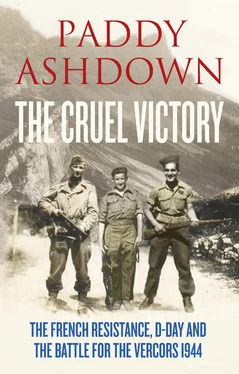During the winter of 1943/4, Le Ray and Chavant did their best, with varying degrees of success, to bring these independent groups under central control. Chavant in particular was strongly opposed to summary executions and insisted, especially latterly, that the death penalty for traitors should be carried out only after due process – even though this was, initially at least, of a fairly rudimentary sort.
By this time, the social base of the local Resistance movement had widened. The Vercors women, involved right from the start in the first Resistance structures, were now playing a more important role. Alongside the domestic burdens of keeping families together while husbands and sons were in the forests and delivering bread, pails of milk or bags of pâté and cheeses to groups of desperate, hungry young men, the women of the Vercors also carried heavy loads when it came to more direct engagement in the active work of the Resistance. Some like Paulette Jacquier led a Maquis group in their own right. Others such as Charlotte Mayaud and Geneviève Blum-Gayet were closely involved from the start in the second Combat Committee which had been established in June. Gaby Lacarrière and Jacqueline Gröll from Sassenage, still in their teens, acted as spies and couriers, carrying out numerous sorties by bicycle through the checkpoints and into Grenoble on missions to gather information or carry vital packages and messages both to and from the plateau. Léa Blain, a young girl from the village of Chatte west of the Vercors Massif, came to the plateau to help with the coding and decoding of secret telegrams for London and subsequently paid for it with her life. As did Rose Jarrand, the schoolmistress at the little village of Les Chabottes close to Saint-Agnan on the plateau, whose classrooms were used for a period as an arms depot.
Pierrette Fave later wrote to her new husband Robert, who was already in the Resistance, explaining why she wanted to join him: ‘The circumstances demanded that we young should be active, not passive … For some, I was just a young girl who ran off. But I was utterly committed – I wanted to join the Resistance as you had done. At 20 you want to change the world. Or at least you want to try. I regret none of it, but it was hard.’ Pierrette Fave was not alone in rejecting passivity in favour of action.
Many local priests felt the same. The Catholic Church within France had initially responded to the Franco-German Armistice by recognizing the legitimacy of the Vichy government and declaring that armed resistance was a mortal sin. At the introduction of the STO the Church hierarchy, fearing civil war, ordered obedience to Laval’s order and advised those called up to follow instructions and leave for Germany. The long-serving Bishop of Grenoble, Alexandre Caillot, known as the ‘most Pétainist Bishop in France’, retained this view till the end of the war. There was also at least one churchman suspected of passing information to the Germans.
But these ‘collaborators’ were the exception. By early 1944, the majority of ordinary priests adopted an increasingly militant, pro-Resistance stance. Some were leaders of Maquis groups – Abbé Pierre led one in the Vercors on the Sornin plateau – while many others served as ordinary footsoldiers. The beautiful twelfth-century abbey and convent at Léoncel, below the south-western edge of the plateau, was used by the wireless operators of at least two clandestine radios in direct communication with London. As one Vercors combatant, no lover of the Church and its ways, put it: ‘The Vercors priests were a rugged breed, and not at all like the soft idiots in the Bishop’s palace. They were deeply integrated into their villages and communities, where the leadership of the priest was much respected. Throughout the long period of suffering and pain of the occupation they never hesitated to show their commitment by publicly castigating from their pulpits, both the Nazis and the French who served them.’ A British officer in the Vercors described one of the local priests bending down to pray over the body of a dead Maquisard, causing his surplice to lift up at the back, revealing ‘the leather belt around his cassock, fixed onto which was a Colt 45 automatic pistol and about half a dozen [hand] grenades’.
Resistance sympathizers also included some who were supposed to be active servants of the Vichy state. Many town Gendarmeries were especially prone to turning a blind eye to Resistance activity – in some cases even participating themselves. By the end of the summer of 1943 most ordinary members of local communities were at least passively sympathetic to the Resistance, though, as we shall see, this may have had less to do with genuine commitment and more to do with the fact that there were almost no penalties attached to supporting or even assisting the Resistance. The Italian occupying forces did not, in the main, indulge in sanctions or reprisals against the civilian population. This was, however, about to change.
*They were called sédentaires – that is, Resistants who stayed in the farms and communities in which they lived and continued their work as normal during the day, but trained secretly as Maquisards at the weekends.
*Probably Le Ray and de Beauregard.
9
PRESSURE AND PARACHUTES
The Allies invaded Italy proper on 3 September 1943. Corsica rose the following day, thanks largely to the Communists but aided by the British. Peeved at being bypassed in the first French liberation victory, de Gaulle later commented sourly, ‘British intelligence, which ordinarily did not go out of their way to be generous without ulterior motive, procured ten thousand machine guns [for the Communists].’ Five days later, on 8 September, Marshal Badoglio (Mussolini had already been deposed on 25 July) signed an armistice between the Italian government and the Allies in Cassibile in Sicily.
The German response to the Italian surrender was pre-planned, swift and bloody. Since 15 July, ten days before the fall of Mussolini, French agents in the Savoie had reported to London that heavy German troop concentrations were seen moving south towards Grenoble. On 6 August, a German infantry division, redeployed from Brittany, was reported transiting the city, heading for the Italian border. On 30 August, the German 157th Reserve Division under the command of the fifty-two-year-old Generalleutnant Karl Ludwig Pflaum established its headquarters in the city.
Within hours of the Italian surrender, German troops occupied Grenoble, forcibly ejecting the Italians from their barracks. There were running battles between Italian and German troops on the streets of the city and a ‘massacre’ of Italian officers at the Hôtel les Trois Dauphins in Place Grenette. Some Italian soldiers immediately joined the Resistance, but most fled for home. Desperate Italian troops were seen passing through the Trièves area heading for the Italian border 70 kilometres away.
With Grenoble under German control, it was not long before the Gestapo arrived in the city. Their headquarters were established in the Hôtel Moderne, while another building, 28 Cours Berriat, was converted into an interrogation centre. This address was soon to become infamous in the city as a place of torture. The Gestapo rapidly found their hands full, not because of the Vercors, but because of what was happening outside their own front door. On a bright afternoon in October Paul Gariboldy emptied a whole magazine from the window of a speeding car at the Milice headquarters in the Hôtel de l’Angleterre less than a kilometre from Gestapo headquarters, shouting, ‘Get out. France is free,’ as his vehicle sped away to the sound of tinkling glass and the echoes of gunfire reverberating from the nearby buildings. On 6 October, a jumpy German sentry shot dead a local engineer who was fumbling in his pocket for his house key. By now, tension was rising dangerously in the city. On 11 November, the anniversary of the signing of the 1918 Armistice, the call went out from Resistance circles for a strong show of defiance to ‘raise our voices once more against the [German] oppression’.
Читать дальше












